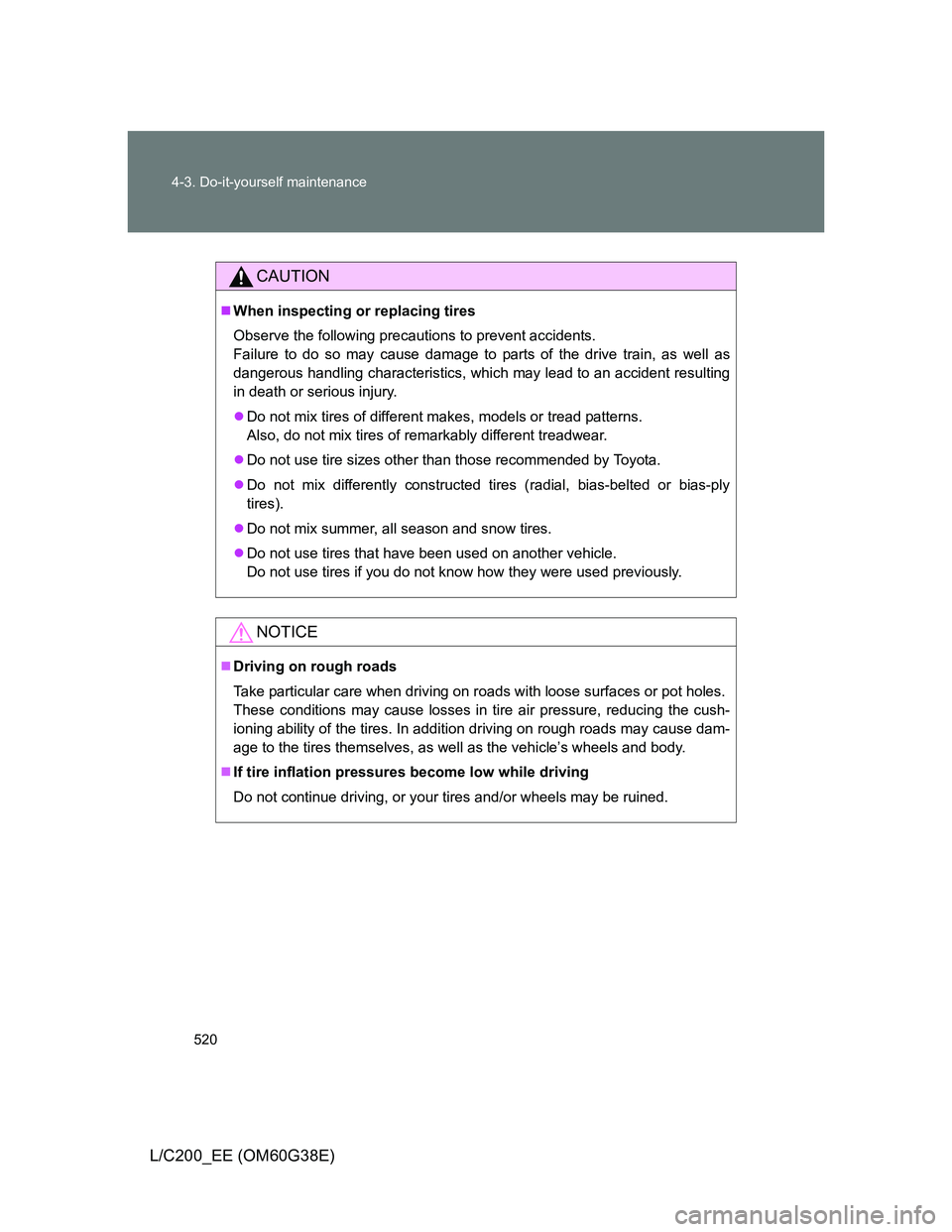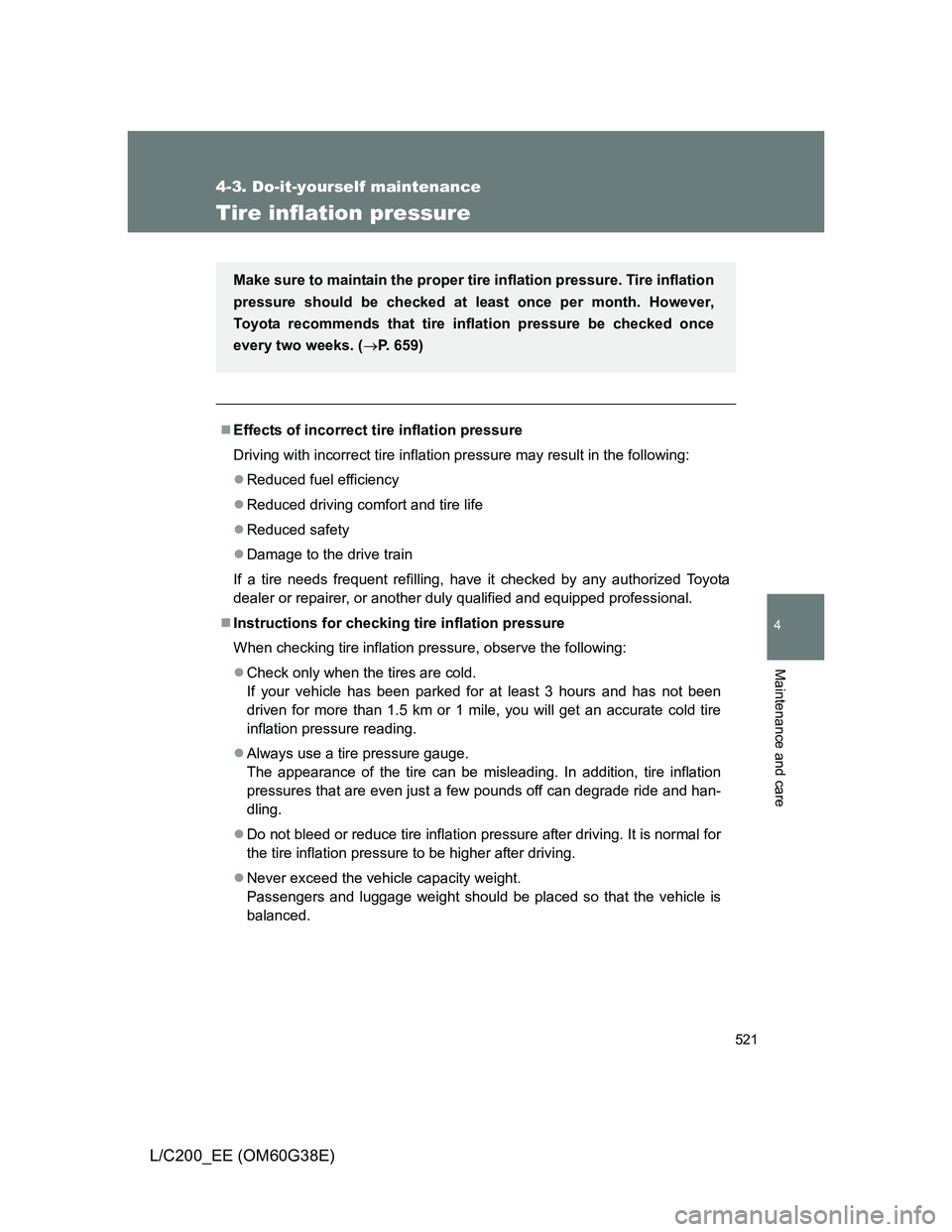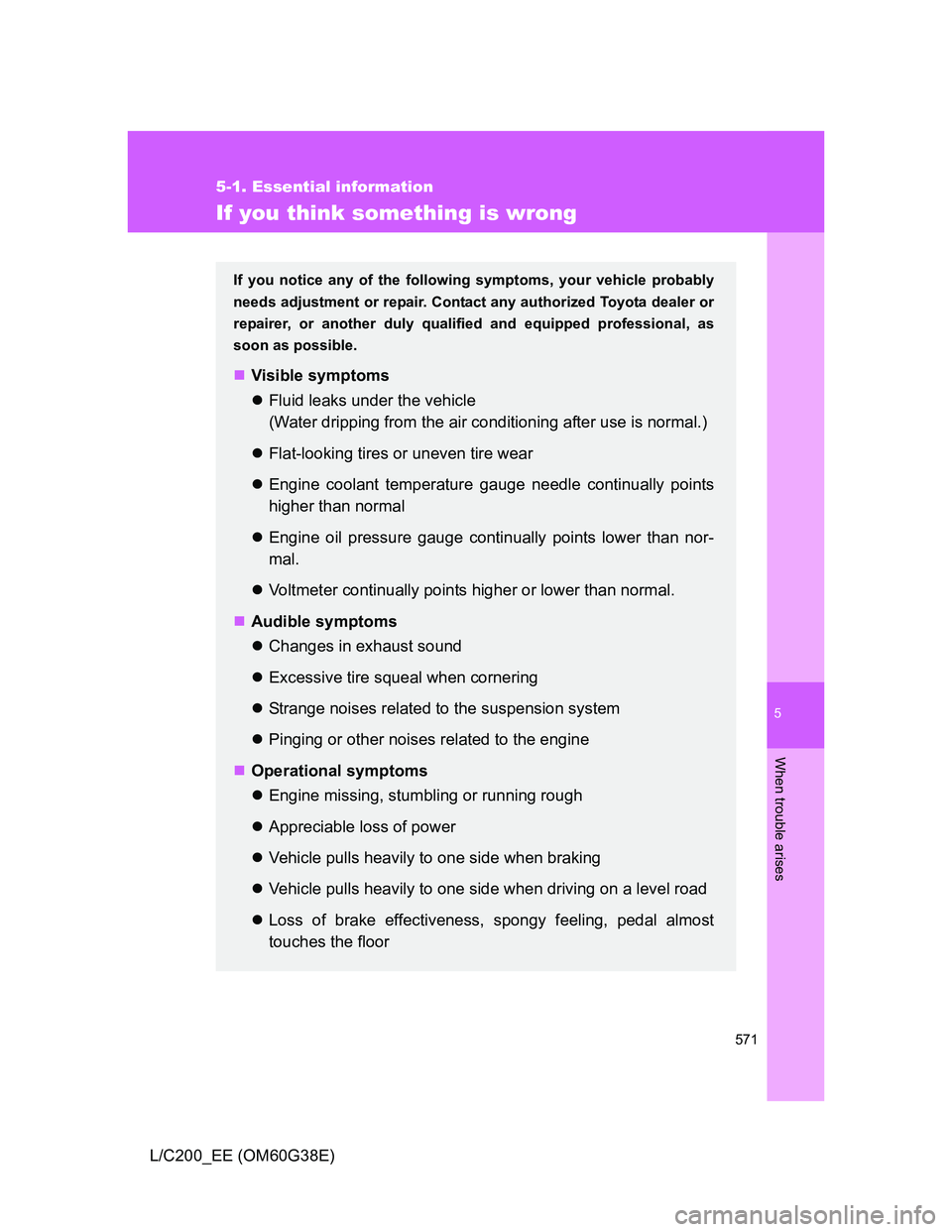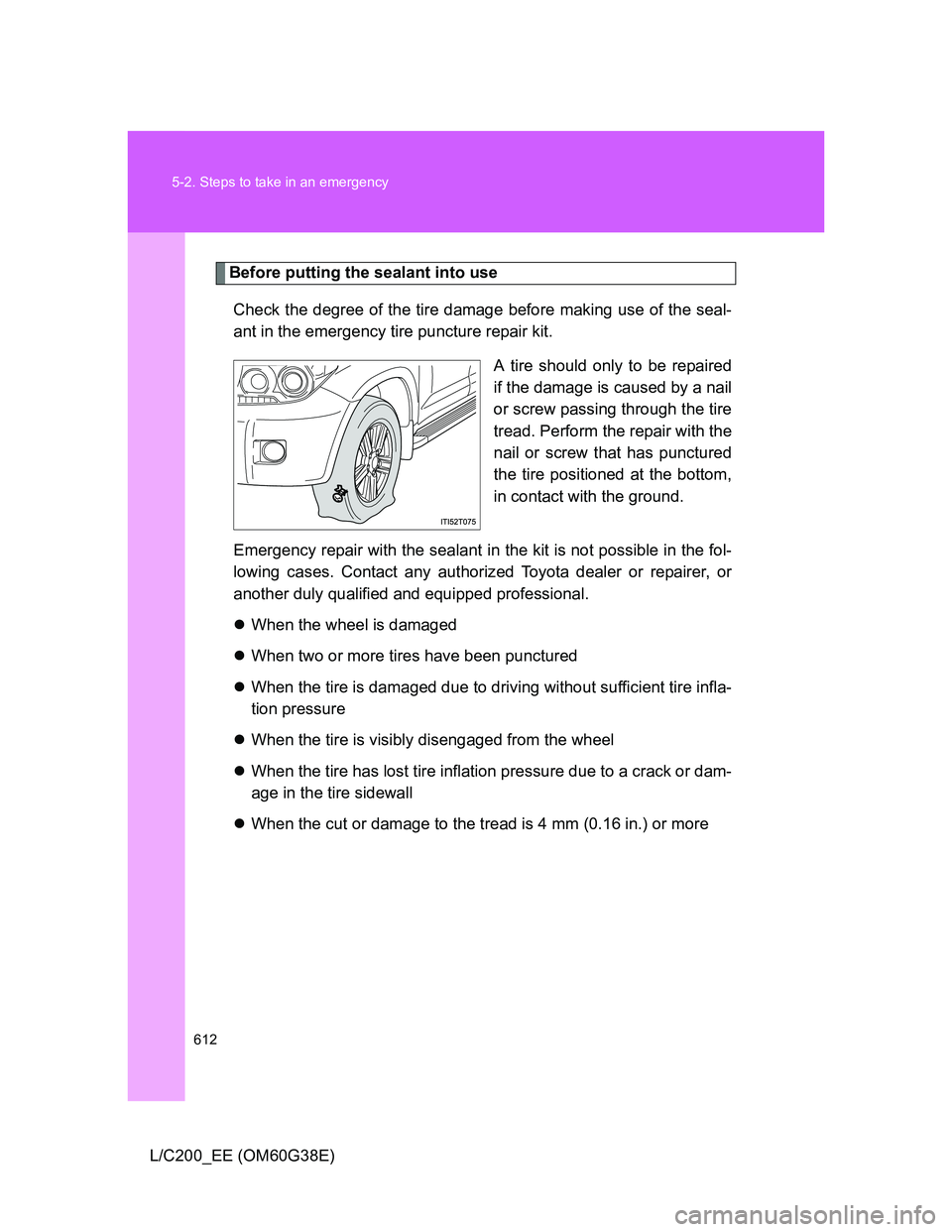Page 498 of 692
498 4-3. Do-it-yourself maintenance
L/C200_EE (OM60G38E)
ItemsParts and tools
Tire inflation pressure (P. 521)• Tire pressure gauge
• Compressed air source
Washer fluid (P. 515)
• Water or washer fluid containing
antifreeze (for winter use)
• Funnel
Page 518 of 692
518
4-3. Do-it-yourself maintenance
L/C200_EE (OM60G38E)
Tires
Replace or rotate the tires in accordance with treadwear.
Checking tires
New tread
Treadwear indicator
Worn tread
The location of treadwear indi-
cators is shown by the “TWI” or
“ ” marks, etc., molded on
the sidewall of each tire.
Check spare tire condition and
inflation pressure if not rotated.
Tire rotation
Rotate the tires in the order
shown.
To equalize tire wear and help
extend tire life, Toyota recom-
mends that you rotate your
tires approximately every 5000
km (3000 miles).
Front
Page 520 of 692

520 4-3. Do-it-yourself maintenance
L/C200_EE (OM60G38E)
CAUTION
When inspecting or replacing tires
Observe the following precautions to prevent accidents.
Failure to do so may cause damage to parts of the drive train, as well as
dangerous handling characteristics, which may lead to an accident resulting
in death or serious injury.
Do not mix tires of different makes, models or tread patterns.
Also, do not mix tires of remarkably different treadwear.
Do not use tire sizes other than those recommended by Toyota.
Do not mix differently constructed tires (radial, bias-belted or bias-ply
tires).
Do not mix summer, all season and snow tires.
Do not use tires that have been used on another vehicle.
Do not use tires if you do not know how they were used previously.
NOTICE
Driving on rough roads
Take particular care when driving on roads with loose surfaces or pot holes.
These conditions may cause losses in tire air pressure, reducing the cush-
ioning ability of the tires. In addition driving on rough roads may cause dam-
age to the tires themselves, as well as the vehicle’s wheels and body.
If tire inflation pressures become low while driving
Do not continue driving, or your tires and/or wheels may be ruined.
Page 521 of 692

521
4-3. Do-it-yourself maintenance
4
Maintenance and care
L/C200_EE (OM60G38E)
Tire inflation pressure
Effects of incorrect tire inflation pressure
Driving with incorrect tire inflation pressure may result in the following:
Reduced fuel efficiency
Reduced driving comfort and tire life
Reduced safety
Damage to the drive train
If a tire needs frequent refilling, have it checked by any authorized Toyota
dealer or repairer, or another duly qualified and equipped professional.
Instructions for checking tire inflation pressure
When checking tire inflation pressure, observe the following:
Check only when the tires are cold.
If your vehicle has been parked for at least 3 hours and has not been
driven for more than 1.5 km or 1 mile, you will get an accurate cold tire
inflation pressure reading.
Always use a tire pressure gauge.
The appearance of the tire can be misleading. In addition, tire inflation
pressures that are even just a few pounds off can degrade ride and han-
dling.
Do not bleed or reduce tire inflation pressure after driving. It is normal for
the tire inflation pressure to be higher after driving.
Never exceed the vehicle capacity weight.
Passengers and luggage weight should be placed so that the vehicle is
balanced.
Make sure to maintain the proper tire inflation pressure. Tire inflation
pressure should be checked at least once per month. However,
Toyota recommends that tire inflation pressure be checked once
every two weeks. (P. 659)
Page 522 of 692
522 4-3. Do-it-yourself maintenance
L/C200_EE (OM60G38E)
CAUTION
Proper inflation is critical to save tire performance
Keep your tires properly inflated. Otherwise, the following conditions may
occur and result in an accident causing death or serious injury.
Excessive wear
Uneven wear
Poor handling
Possibility of blowouts resulting from overheated tires
Poor sealing of the tire bead
Wheel deformation and/or tire separation
A greater possibility of tire damage from road hazards
NOTICE
When inspecting and adjusting tire inflation pressure
Be sure to reinstall the tire valve caps.
Without the valve caps, dirt or moisture could get into the valve and cause
air leakage, which could result in an accident. If the caps have been lost,
replace them as soon as possible.
Page 571 of 692

5
571
5-1. Essential information
When trouble arises
L/C200_EE (OM60G38E)
If you think something is wrong
If you notice any of the following symptoms, your vehicle probably
needs adjustment or repair. Contact any authorized Toyota dealer or
repairer, or another duly qualified and equipped professional, as
soon as possible.
Visible symptoms
Fluid leaks under the vehicle
(Water dripping from the air conditioning after use is normal.)
Flat-looking tires or uneven tire wear
Engine coolant temperature gauge needle continually points
higher than normal
Engine oil pressure gauge continually points lower than nor-
mal.
Voltmeter continually points higher or lower than normal.
Audible symptoms
Changes in exhaust sound
Excessive tire squeal when cornering
Strange noises related to the suspension system
Pinging or other noises related to the engine
Operational symptoms
Engine missing, stumbling or running rough
Appreciable loss of power
Vehicle pulls heavily to one side when braking
Vehicle pulls heavily to one side when driving on a level road
Loss of brake effectiveness, spongy feeling, pedal almost
touches the floor
Page 612 of 692

612 5-2. Steps to take in an emergency
L/C200_EE (OM60G38E)
Before putting the sealant into use
Check the degree of the tire damage before making use of the seal-
ant in the emergency tire puncture repair kit.
A tire should only to be repaired
if the damage is caused by a nail
or screw passing through the tire
tread. Perform the repair with the
nail or screw that has punctured
the tire positioned at the bottom,
in contact with the ground.
Emergency repair with the sealant in the kit is not possible in the fol-
lowing cases. Contact any authorized Toyota dealer or repairer, or
another duly qualified and equipped professional.
When the wheel is damaged
When two or more tires have been punctured
When the tire is damaged due to driving without sufficient tire infla-
tion pressure
When the tire is visibly disengaged from the wheel
When the tire has lost tire inflation pressure due to a crack or dam-
age in the tire sidewall
When the cut or damage to the tread is 4 mm (0.16 in.) or more
Page 617 of 692
5
617 5-2. Steps to take in an emergency
When trouble arises
L/C200_EE (OM60G38E)Check the specified inflation pressure.
The label is placed as shown in the illustration.
Left-hand drive vehicles
Right-hand drive vehicles
Turn the compressor switch “ON”
and fill the tire with air until the
specified inflation pressure is
reached.
STEP14
STEP15
Switch